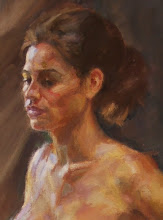
The artists of the Proto Renaissance were the forerunners of the science of vision much of their efforts went into conveying a story. Now we have so many forms of moving images and still images created at the touch of a button, the value of painting now lies entirely in the act of painting, that is in the observation made by the artist and his idiosyncratic ability to put this study into paint.
Painting now is only of value if done by a genius. Now that story telling has so many other forms of expression there is no value what so ever in low-grade painting. There have been many claims that poor painting is rather good because it is the message that give it value. And which have not only been supported, but enthusiastically championed by ‘art experts’. One such is Professor Griselda Pollock’s championing of Frida Kahlo whose work can only be described as painfully immature; lacking in all that long list of artistic values.
In fact lacking so much more than Seurat, Cezanne, or Hockney, that she is on the borderline of primitive. (Primitive by the way is not a compliment it just means someone who is visually illiterate). Her work usually has reference to the female struggle or, as with her husbands work, the oppression of the Mexicans. To put this into perspective my question would be: do these almost primitive works on the buildings in Ireland by supporters of the IRA or the Loyalists make the painters artists because they convey a message. I will save Griselda Pollock both time and effort in trying to work out the answer, no of course not. Whether it is a message by Frida Kahlo the IRA or Loyalists supporters or Magritte the answer is a resounding no. I say no but I really mean: I think we are safe in saying that it is unlikely that we would find anyone who would argue with this. In other words I do not want anything I write to seem proscriptive. I am the last person to want to throw out the baby with the bath water. I love the eccentric and wacky, I am only pointing out the uncontensious boundaries. There have often been artists in the past who have said this or that is art and thereby, this or that is not art. Such as the constructavists who made great play of their path being the only correct path and that representationalism was not art because it could never be as close a representation of that which it copies;
Robert Delaunay “If art relates itself to an object, it becomes descriptive, divisionist, literary. It demeans itself by imperfect means of expression, it condemns itself, it is its own negation.”
But this would not have been the generally accepted view. For with, our baseline example Jan Six this is not a failing. My aim is only to eliminate those aspects which are not in contention. This will inevitably call for a degree of reasoning but hopefully not reasoning which contains any fundamental debate. Hence the choice of the paintings on the buildings in the Irish conflict. It has never been claimed to my knowledge that the message here has given rise to the painters being elevated to great artists. Therefore I think it wholly reasonable to set this against the unreasonable and unfounded claims of Professor Griselda Pollock. My antenna alert me to the danger of visual illiterates when I hear someone trying to use reasons which are other than visual to establish that a painting is a visual work of art. It is to my everlasting amazement that one from the art service industry reinforced the belief that the story line in the painting was anything by a subordinate element. When asked by an interviewer on a radio programme; what made a painting, in the case “Bacchus and Ariadne” worth so many million, was it the way in which is was painted, the story line, or the fame of the artist? Matthew Collins replied “Not the bloody story line. Bacchus and Ariadne are not that interesting.” One cannot help thinking why would anyone think, the story line. Until one realises that to some the painting is no more than a picture. The floundering for a reason confirms this. To a visual illiterate it must be so confusing to see people derive so much from a mere picture sometimes of no more interest than the painters face. If the art of the painting count for nothing then it is easy to understand the enormous growth of the contorted and mythical meanings of art; some of which we have attempted to explode here.




















